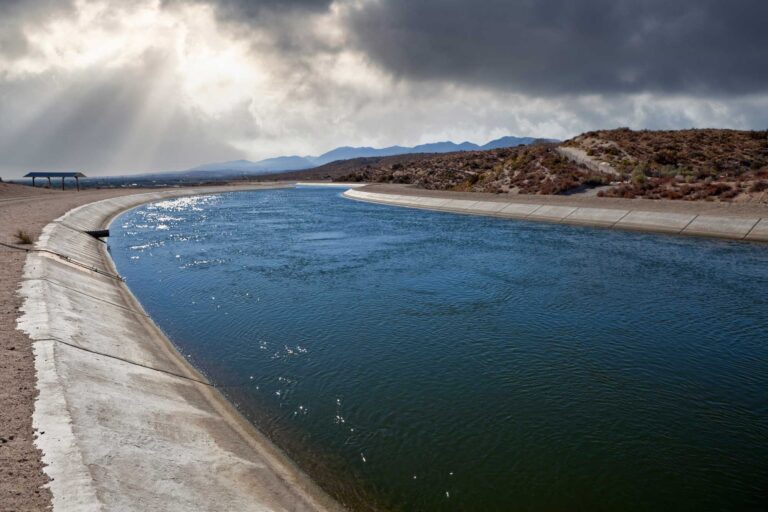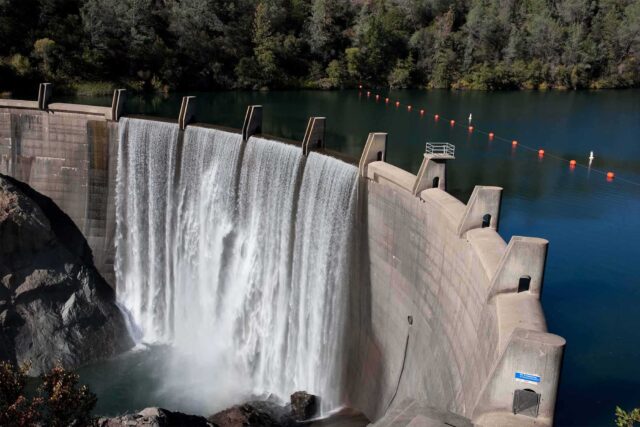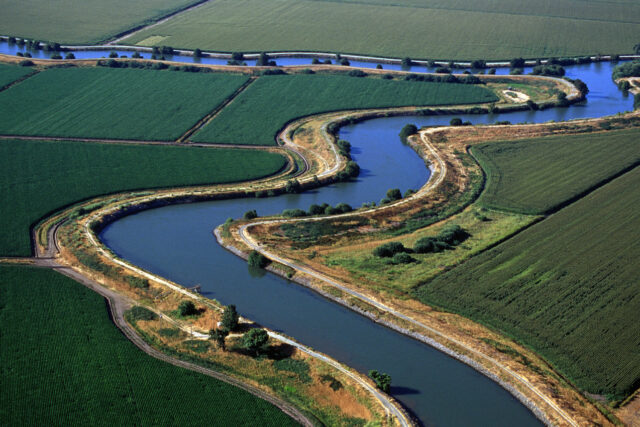PPIC Water Policy Center director Ellen Hanak, senior fellow Brian Gray, and senior fellow Jeffrey Mount testified before the Assembly Water, Parks, and Wildlife Committee Informational Hearing, “How Should California’s Water Right System Adapt to a 21st Century Climate?” Here are their prepared remarks.
Introduction
The climate shifts that California is experiencing—with warmer temperatures, less reliable snowpack, and more intense droughts—have exposed critical weaknesses in the administration of our water rights system under conditions of scarcity. In particular, there are challenges curtailing diversions when supplies are inadequate. And on the flip side, this system also needs the capacity to better facilitate the management of abundance, by permitting the capture of more water from large storms to recharge groundwater basins.
In our remarks today we recap some of the key challenges the changing climate is posing for California’s water rights system in both dry and wet times, illustrate how these issues are playing out in the state’s largest watershed, and offer some recommendations for how the legislature could help strengthen the water rights system to better respond to water scarcity and abundance.
The Growing Challenges of Managing Water in a Warming, Increasingly Volatile Climate
California has the most volatile climate in the nation, with large swings in precipitation across years. In consequence, our water infrastructure and operations have long had the goal of managing for both multi-year droughts and episodic floods. Climate models project warming temperatures, reduced snowpack, shorter and more intense wet seasons, and increased year-to-year volatility in precipitation—with drier dries and wetter wets. These changes are making the management of both dry and wet periods increasingly difficult.
Over the past two decades, California has experienced significant warming. This reduces the share of precipitation that falls as snow—historically an important part of seasonal water storage—and it contributes to another growing phenomenon: atmospheric demand. This increasing “thirst of the atmosphere” is reducing water availability by further eroding snowpack, drying out soils, and increasing plants’ water demands. In short, California’s dry periods are getting drier. The two latest droughts—from 2012–16 and 2020–2022—have broken records for their combination of warmth and dryness. In both droughts, our spring runoff forecasts—based on the historical behavior of snowpack—underestimated how dry things would get. Unprecedented, widespread water right curtailments became necessary because there simply wasn’t enough water in rivers and streams to supply all water rights and comply with regulatory and public trust requirements.
California gets most of its water from a few big winter and early spring storms, and climate models project these storms will intensify. Although we have experienced some record storms in recent years, it is too soon to tell whether our wet periods have become wetter. But what’s already clear is that we need to do a better job capturing and storing more runoff from high-flow storms. This is an important adaptation strategy for managing our warmer, drier droughts, and it is also essential for bringing overdrafted groundwater basins into balance under the 2014 Sustainable Groundwater Management Act (SGMA). While there is some potential to expand surface storage, the biggest—and most cost-effective—opportunities lie in groundwater recharge.
Effectively addressing the growing challenges of managing water in dry and wet times will require a range of actions by multiple parties. But one essential area for improvement is administration of the water rights system. Despite recent progress, the State Water Board still lacks adequate authority to enforce and curtail water rights under conditions of scarcity. And it needs to become more nimble at approving permits to recharge groundwater basins with water from large storms.
Recent Lessons from the Sacramento–San Joaquin River and Delta Watershed
As we show in a recent PPIC study, Tracking Where Water Goes in a Changing Sacramento–San Joaquin Delta, the dual challenges of managing scarcity and abundance have been on full display in California’s largest watershed—which supplies water to some 30 million residents and 6 million acres of farmland, and supports an important, and threatened, ecosystem.
- Dry-year challenges. Recent droughts have proved especially challenging for the management of water supply, water quality, and ecological flows, but one year stands out. In 2021—a warm year with low precipitation and high evaporative demand of the atmosphere—all of that year’s runoff in the watershed was used upstream or within the Delta. In consequence, all of the water required to manage water quality, protect ecosystems, and serve export water demands had to be met from water stored in upstream reservoirs. Even though 2019 was a very wet year, these reservoirs were depleted by early 2021 because 2020 had also been dry. The State Water Board curtailed upstream and in-Delta diverters, but these orders likely came too late in the irrigation season to make a difference.
- Wet-year challenges. An analysis of water availability in the three most recent wet years—2011, 2017, and 2019—shows that there is ample opportunity to capture and store more water from large storms in such years without causing harm to ecosystems. This includes storing more water south of the Delta—which could be accomplished under existing diversion rights and regulations—and expanding recharge efforts upstream of the Delta, which will often require new high-flow diversion permits. The nine atmospheric river storms that pelted the state earlier this winter also created such opportunities, but taking advantage of them remains a work-in-progress, in part because of permitting challenges.
Recommendations for Better Managing Scarcity and Abundance
The State Water Board—with support from the legislature—has made important progress in adapting the water rights system to better manage both scarcity and abundance. To manage scarcity, the legislature gave the board explicit curtailment authority in a 2014 amendment to Water Code § 1058.5 (SB 104). A 2015 bill (SB 88) introduced new measurement and reporting requirements for surface water diverters—essential for helping the board understand and oversee diversions at a local level. The board has also been developing a “water unavailability” modeling framework for the state’s rivers and streams, to better anticipate when diversions will need to be curtailed during droughts. And to manage abundance, the board developed special permitting guidelines for temporary and long-term permits to divert high-water flows for groundwater recharge in 2019, building on legislation (AB 658) that authorized it to issue temporary permits to Groundwater Sustainability Agencies (GSAs) and other local water managers to advance groundwater sustainability.
This is significant progress, but more work is needed to bring water rights administration up to the tasks at hand. Here, we offer several recommendations for additional legislative action that could substantially improve the system’s ability to support California’s communities, farms, and environment during wet and dry periods. A note accompanying this testimony provides additional details.
To better manage scarcity:
- Expressly authorize the State Water Board to enforce and curtail all relevant water rights.
One major obstacle the board has faced in enforcing the water rights system is the fact that its permitting authority is limited to surface water rights established from 1914 onwards. This excludes a substantial portion of diversions—perhaps a third or more statewide—that are under riparian rights or pre–1914 appropriative rights. Recent droughts have been so severe that even these high priority rights have required curtailment in some watersheds—with the Delta and its watershed as a case in point. While case law has recently established that the board does have authority to curtail these surface rights, it would be helpful for the legislature to clarify this. By the same token, the board should be granted express authority to enforce and curtail groundwater rights that significantly affect surface waters—a concern in some watersheds. - Enable the board to respond more quickly to changing conditions.
Although the curtailment authority granted to the board in 2014 under § 1058.5 has been helpful, it currently contains two overly restrictive triggers: the board can only order curtailments if the governor declares a drought emergency, or during a critically dry year immediately preceded by two or more consecutive below-normal, dry, or critically dry years. We recommend relaxing these conditions. As recent experience has shown, conditions can evolve quickly; the extreme conditions of 2021 came just a year after a very wet 2019. Conditions in specific watersheds may also warrant attention before the governor declares a regional or statewide drought emergency. - Create incentives to improve measurement and reporting of diversions and use.
Obtaining accurate reporting of diversions has been a longstanding challenge in California; before legislation enacted in 2009 (SBX7 8), there was limited information on riparian and pre-1914 diversions, as these users faced little incentive to report. Although reporting has improved—especially since the passage of SB 88—there are still important gaps. Compliance with the requirement to use approved measurement devices is low, and adherence to reporting requirements is uneven. Yet understanding diversions and use is critical to the effective administration of water rights. To improve the board’s access to timely information, we recommend increasing the frequency of reporting required under SB 88—which now requires annual reporting of monthly data, too little and too late for managing droughts. And to incentivize compliance with measurement and reporting requirements, we also recommend considering legislation that would place the burden of proving both the existence of a valid water right and the lawful exercise of that right on the water right holder. - Encourage renegotiation of CVP and SWP senior contracts.
Although this goes beyond the issue of water rights administration, one additional finding from our Delta analysis is worth noting here: The current contracts with senior water users under both the Central Valley Project and the State Water Project promise water deliveries that can no longer be supported in many drier years. These contracts were written when the hydrology of the basin was quite different, and the volume of Delta outflow needed for salinity control was woefully underestimated. Meeting the terms of these contracts likely exceeded the volume of water that would have been available under the contractors’ pre-contract water rights in 2021. In 2022, even more dire conditions in Lake Shasta led to negotiations with CVP settlement contractors, who accepted unprecedented one-time cutbacks in their contract allocations. In California’s changing climate, it behooves all parties to renegotiate these contracts, to facilitate more flexible management of increasingly intense drought, while acknowledging the seniority of these water users. The legislature could encourage this next step.
To better manage abundance:
- Empower the State Water Board to administer a special permitting system for high-water flows.
Although it builds on AB 658, most of the high flow permitting program is the board’s own creation. It would be useful for the legislature to confirm the board’s authority to issue special temporary and long-term permits for the diversion and storage of high-water flows. - Develop watershed-specific high-flow diversion thresholds.
The board’s streamlined permits are currently available only for diversions during “high flow events,” which the guidelines define as (1) daily streamflow above the 90th percentile; and (2) high flows that trigger flood control actions necessary to mitigate threats to human health or safety. This is a useful starting point for ensuring that these diversions do not harm other water users or the environment. But there may be conditions when these thresholds are either too low (if existing water rights already encompass these flows, or if special ecological conditions warrant further limitations) or too high (if additional diversions would not cause harm.) We therefore recommend considering legislation that would direct the board to engage with the Department of Water Resources (DWR) and relevant basin stakeholders to study the appropriate thresholds for watersheds that are likely to be the source of future high flow diversions. The board could then set new diversion thresholds for each individual watershed. - Confirm that recharge with high flows is a beneficial use of water.
Although the board has determined that “groundwater recharge is not a beneficial use of water on its own,” it has built on the language in AB 658 to broadly define beneficial use in this context. This includes a variety of in situ beneficial uses from the underground storage itself, such as prevention of salt-water intrusion, subsidence, harm to groundwater-dependent ecosystems, and other undesirable results that groundwater sustainability plans must work to avoid under SGMA. This flexibility is not widely understood, and the definition of beneficial use for groundwater storage and recharge has been a contentious topic. It would be helpful for the legislature to confirm the board’s broad interpretation for its high flow diversion and storage program. - Allow for quick action when storms come.
As with enforcement and curtailment of water rights during periods of acute shortage, rapidly changing high-flow and flood conditions also require prompt action—both by the board and by parties seeking to divert the flows when they are still available. New legislation could further this goal by authorizing the use of programmatic hydrologic and environmental analyses that the board could use to review and approve specific high-flow diversion requests on an expedited basis.
Conclusion
California relies upon its water rights system to manage competing demands for water. Originally, this system was set up to manage scarcity, but increasingly, it is being asked to manage all facets of both wet and dry periods, along with complying with regulatory standards and fulfilling public trust requirements.
The legislature has a long history of adapting the water rights system to respond to new scientific information, changing hydrology, and evolving public values. Given the events of the past decade—along with projections of future climate change—it is appropriate for the legislature to update the Water Code to reflect these new conditions. In this testimony we offer suggestions for Water Code amendments, along with recommendations to revisit senior water right contracts. Although these policy reforms are modest, they are an important next step in matching water rights administration to current and future needs.
To see the briefing slides that accompanied this presentation, click here.






